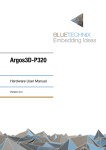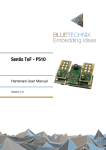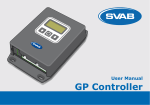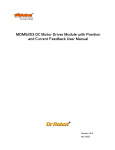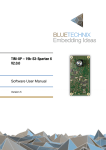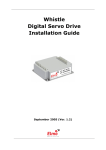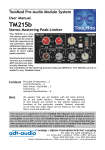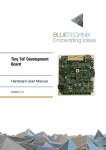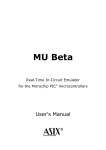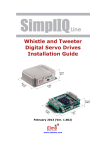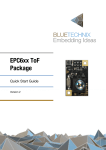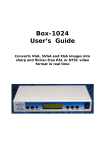Download Argos 3D - P310
Transcript
Argos 3D - P310 Hardware User Manual Version 1.4 Bluetechnix Waidhausenstraße 3/19 A-1140 Vienna AUSTRIA [email protected] www.bluetechnix.com Argos 3D - P310 – Hardware User Manual Document No.: 900-308 / A Publication date: April 17, 2015 Subject to change without notice. Errors excepted. This document is protected by copyright. All rights reserved. No part of this document may be reproduced or transmitted for any purpose in any form or by any means, electronically or mechanically, without expressly written permission by Bluetechnix GmbH. Windows is a registered trademark of Microsoft. © Bluetechnix 2015 Table of Contents 1 General Information .......................................................................................................................... 6 1.1 Symbols Used ........................................................................................................................... 6 1.2 Certification ............................................................................................................................... 7 1.2.1 CE Declaration ................................................................................................................... 7 1.2.2 FCC Declaration ................................................................................................................. 7 1.2.3 Eye Safety .......................................................................................................................... 7 Illumination: LEDs ................................................................................................................................ 7 Wavelength .......................................................................................................................................... 7 850nm (typ) .......................................................................................................................................... 7 In accordance with EN62471:2008 resp. IEC62471:2006 ................................................................... 7 Output power ....................................................................................................................................... 7 TBD ...................................................................................................................................................... 7 2 3 1.3 Safety instructions .................................................................................................................... 8 1.4 Electrical connection ................................................................................................................. 8 Overview ........................................................................................................................................... 9 2.1 Components.............................................................................................................................. 9 2.2 Interfaces and Connectors ...................................................................................................... 10 Hardware Installation ..................................................................................................................... 11 3.1 4 Mounting ................................................................................................................................. 11 3.1.1 Mounting Holes (a) ........................................................................................................... 11 3.1.2 Mount Spacing ................................................................................................................. 11 Board Description .......................................................................................................................... 12 4.1 Signal naming.......................................................................................................................... 12 4.2 Connector Numbering............................................................................................................. 12 4.3 Interface-Slot........................................................................................................................... 12 4.3.1 Ethernet (a) ....................................................................................................................... 13 4.3.2 General purpose output 1 & 2 (b) .................................................................................... 13 4.3.3 General purpose output 3 & 4 (c) ..................................................................................... 13 4.3.4 General purpose input 1 & 2 (d) ....................................................................................... 14 4.3.5 RS232/RS485 (e) ............................................................................................................. 14 4.3.6 CAN-Bus (f) ...................................................................................................................... 15 4.3.7 Modulation Interface (LVDS) (g) ....................................................................................... 15 4.3.8 DIP-Switch (h) .................................................................................................................. 16 4.3.9 Trigger and RS232 (i) ....................................................................................................... 16 4.3.10 Power Connector (j) ......................................................................................................... 16 4.3.11 I2C (c) ............................................................................................................................... 17 © Bluetechnix 2015 5 6 7 4.3.12 Boot loader mode button (k) ............................................................................................ 17 4.3.13 Reset-Button (l) ................................................................................................................ 17 4.3.14 USB (m) ............................................................................................................................ 17 Software ......................................................................................................................................... 18 5.1 Firmware ................................................................................................................................. 18 5.2 Demo Application .................................................................................................................... 18 5.3 Getting Started Software Development Example ................................................................... 18 Appendix ........................................................................................................................................ 19 6.1 Operating Conditions .............................................................................................................. 19 6.2 Mechanical Outline.................................................................................................................. 19 Support ........................................................................................................................................... 21 7.1.1 8 7.2 Software Packages ................................................................................................................. 21 7.3 Related Products .................................................................................................................... 21 Product History .............................................................................................................................. 22 8.1 Version Information ................................................................................................................. 22 8.1.1 9 General Support ............................................................................................................... 21 Argos3D-P310 ................................................................................................................. 22 8.2 Anomalies ................................................................................................................................ 22 8.3 Document Revision History .................................................................................................... 22 Index ............................................................................................................................................... 23 © Bluetechnix 2015 © Bluetechnix 2015 All Rights Reserved. The information herein is given to describe certain components and shall not be considered as a guarantee of characteristics. Terms of delivery and rights of technical change reserved. We hereby disclaim any warranties, including but not limited to warranties of non-infringement, regarding circuits, descriptions and charts stated herein. Bluetechnix makes and you receive no warranties or conditions, express, implied, statutory or in any communication with you. Bluetechnix specifically disclaims any implied warranty of merchantability or fitness for a particular purpose. Bluetechnix takes no liability for any damages and errors causing of the usage of this board. The user of this board is responsible by himself for the functionality of his application. He is allowed to use the board only if he has the qualification. More information is found in the General Terms and Conditions (AGB). Information For further information on technology, delivery terms and conditions and prices please contact Bluetechnix (http://www.bluetechnix.com). Warning Due to technical requirements components may contain dangerous substances. © Bluetechnix 2015 User Manual - Argos 3D - P310 1 Last change: 17 April 2015 Version 1.4 General Information This guide applies to the Argos 3D - P310 camera platform from Bluetechnix. Follow this guide chapter by chapter to set up and understand your product. If a section of this document only applies to certain camera parts, this is indicated at the beginning of the respective section. 1.1 Symbols Used This guide makes use of a few symbols and conventions: Warning Indicates a situation which, if not avoided, could result in minor or moderate injury and/or property damage or damage to the device. Caution Indicates a situation which, if not avoided, may result in minor damage to the device, in malfunction of the device or in data loss. Note Notes provide information on special issues related to the device or provide information that will make operation of the device easier. Procedures A procedure always starts with a headline 1. The number indicates the step number of a certain procedure you are expected to follow. Steps are numbered sequentially. This sign indicates an expected result of your action. References This symbol indicates a cross reference to a different chapter of this manual or to an external document. © Bluetechnix 2015 Page 6 | 23 User Manual - Argos 3D - P310 1.2 1.2.1 Last change: 17 April 2015 Version 1.4 Certification CE Declaration Bluetechnix hereby declares that this Argos 3D - P310 product is in compliance with the essential requirements and other relevant provisions of Directive 2004/108/EC. 1.2.2 FCC Declaration This device complies with part 15 of the FCC rules. Operation is subject to the following two conditions: (1) this device may not cause harmful interference, and (2) this device must accept any interference received, including interference that may cause undesired operation. This equipment has been tested and found to comply with the limits for a Class A digital device, pursuant to part 15 of the FCC Rules. These limits are designed to provide reasonable protection against harmful interference when the equipment is operated in a commercial environment. This equipment generates, uses, and can radiate radio frequency energy and, if not installed and used in accordance with the instruction manual, may cause harmful interference to radio communications. Operation of this equipment in a residential area is likely to cause harmful interference in which case the user will be required to correct the interference at his own expense. FCC ID: SSZA3DP31015020 Trade Name: Bluetechnix Group GmbH Model: Argos 3D – P310 Classification of ITE (EN55022) This is a class A product. In a domestic environment this product may cause radio interference in which case the user may be required to take adequate measures. 1.2.3 Eye Safety Illumination: LEDs © Bluetechnix 2015 Wavelength Output power 850nm (typ) TBD In accordance with EN62471:2008 resp. IEC62471:2006 Page 7 | 23 User Manual - Argos 3D - P310 1.3 Last change: 17 April 2015 Version 1.4 Safety instructions Important This manual is part of the device and contains information and illustrations about the correct handling of the device and must be read before installation or use. Observe the operating instructions. Non-observance of the instructions, operation which is not in accordance with use as prescribed below, wrong installation or handling can affect the safety of people and machinery. The installation and connection must comply with the applicable national and international standards. Responsibility lies with the person installing the unit. 1.4 Electrical connection Note The unit must be connected by a qualified electrician. Device of protection class III (PC III). The electric supply must only be made via PELV circuits. The device must only be powered by a limited energy source (≤ 30V; ≤ 8A; ≤ 100VA). Disconnect power before connecting the unit. © Bluetechnix 2015 Page 8 | 23 User Manual - Argos 3D - P310 2 2.1 Last change: 17 April 2015 Version 1.4 Overview Components e a c b c b a d Figure 2-1 Argos3D-P310 components a. Case b. Viewing window for 3D sensor c. Viewing window for illumination module d. Interface board e. Interface cover © Bluetechnix 2015 Page 9 | 23 User Manual - Argos 3D - P310 2.2 Last change: 17 April 2015 Version 1.4 Interfaces and Connectors a b d f i m h c Marks Pin #1 e g j k l Figure 2-2: Argos3D-P310 connectors and interfaces a. Ethernet (RJ45) 10/100/Base-T b. General purpose outputs, galvanic isolated c. General purpose outputs, galvanic isolated d. General purpose inputs, galvanic isolated e. RS232/485 f. CAN-Bus g. Modulation Light Interface h. DIP-Switch i. Trigger, UART j. Power supply * k. Boot loader mode button l. Reset button m. USB * The socket-outlet shall be installed near the equipment and shall be easily accessible. © Bluetechnix 2015 Page 10 | 23 User Manual - Argos 3D - P310 3 Last change: 17 April 2015 Version 1.4 Hardware Installation 3.1 Mounting Caution Case may become hot! 180.60 161.70 a Figure 3-1: Mounting holes for the case 3.1.1 Mounting Holes (a) The case has four M3 holes that allows mounting the Argos3D-P310. 3.1.2 Mount Spacing The device is primarily intended for mounting on a wall or the ceiling. Leave enough space for air circulation. © Bluetechnix 2015 Page 11 | 23 User Manual - Argos 3D - P310 4 Last change: 17 April 2015 Version 1.4 Board Description 4.1 Signal naming Signal names are usually written in capital letters. They are noted in positive logic (positive asserted). If the signal is negative asserted an “n” will be added as prefix to the signal name. Type: The type describes the electrical characteristics of the signal. The following types are available: 4.2 I Input O Output DN Negative Differential Output DP Positive Differential Output P Power supply 3.3V TTL TTL compatible signal with 3.3V high level and 0V low level 5V tolerant Accepts 5V input level Connector Numbering All pins no. 1 of each connector are marked in the figures with a red arrow. The connector numbering always starts at this pin, continuing in this row, and going backwards at the opposite side. Markes Pin #1 4.3 Interface-Slot a b d f i m h Marks Pin #1 c e g j k l Figure 4-1: Argos3D-P310 connector location © Bluetechnix 2015 Page 12 | 23 User Manual - Argos 3D - P310 4.3.1 Last change: 17 April 2015 Version 1.4 Ethernet (a) These are standard straight RJ45 10/100 Base-T compatible Ethernet connectors. They are connected to an Ethernet switch. Both Ethernet connectors can be used to connect multiple cameras in a daisy chain. 4.3.2 General purpose output 1 & 2 (b) This 4 pole 3.5mm terminal connector allows plugging a cable entry plug like 691361100004 from Würth Elektronik. No. 1 2 3 4 Signal OUT1A OUT1B OUT2A OUT2B Type SPST-A SPST-B SPST-A SPST-B Description Relay contact A Relay contact B Relay contact A Relay contact B Table 4-1: General purpose output 1 & 2 connector description A solid state relay ASSR-3210 from Avago Technologies is used for each general purpose output. Voltage range: 18V to 30V. Current range: 0mA to 200mA. Note The cable length should not exceed 3m. 4.3.3 General purpose output 3 & 4 (c) This 4 pole 3.5mm terminal connector allows plugging a cable entry plug like 691361100004 from Würth Elektronik. No. 1 Signal OUT3A 2 OUT3B 3 OUT4A 4 OUT4B Type SPST-A 0V to 30V SPST-B 0V to 30V SPST-A 0V to 30V SPST-B 0V to 30V Description Relay contact A Relay contact B Relay contact A Relay contact B Table 4-2: General purpose output 3 & 4 connector description A solid state relay ASSR-3210 from Avago Technologies is used for each general purpose output. Voltage range: 18V to 30V. Current range: 0mA to 200mA. © Bluetechnix 2015 Page 13 | 23 User Manual - Argos 3D - P310 Last change: 17 April 2015 Version 1.4 Note The cable length should not exceed 3m. 4.3.4 General purpose input 1 & 2 (d) This 4 pole 3.5mm terminal connector allows plugging a cable entry plug like 691361100004 from Würth Elektronik. No. 1 Signal IN2A 2 IN2B 3 IN1A 4 IN1B Type I 0V to 50V I 0V to 50V I 0V to 50V I 0V to 50V Description Relay contact A Relay contact B Relay contact A Relay contact B Table 4-3: General purpose input 1 & 2 connector description An opto-coupler SFH6286-2T from Vishay is used for each general purpose input. OFF-Range: 0V to 2V. ON-Range: 5V to 50V. Note The cable length should not exceed 3m. 4.3.5 RS232/RS485 (e) This 3 pole 3.5mm terminal connector allows plugging a cable entry plug like 691361100003 from Würth Elektronik. No. 1 2 3 Signal GND RS232 RxD1) RS485 A/Y RS232 TxD1) RS485 B/Z Type P IO DN IO DP Description Signal Ground RS232 Receive Data RS485 Negative Differential Data RS232 Transmit Data RS485 Positive Differential Data Table 4-4: GPIO Connector Description 1) The interface mode can be selected with the DIP-Switch (see chapter 4.3.8). The RS232 interface is running in full duplex mode and the RS485 is running in half duplex mode. © Bluetechnix 2015 Page 14 | 23 User Manual - Argos 3D - P310 Last change: 17 April 2015 Version 1.4 Note The cable length should not exceed 60m. 4.3.6 CAN-Bus (f) This 3 pole 3.5mm terminal connector allows plugging a cable entry plug like 691361100003 from Würth Elektronik. No. 1 2 3 Signal CAN_P CAN_N GND Type DP DN P Description CAN H CAN L Power Ground Table 4-5: CAN-Bus connector description Note The cable length should not exceed 60m. 4.3.7 Modulation Interface (LVDS) (g) This 3 pole 3.5mm terminal connector allows plugging a cable entry plug like 691361100003 from Würth Elektronik. No. 1 2 3 Signal GND MOD_P MOD_N Type P DP DN Description Power ground Modulation signal output+ Modulation signal output- Table 4-6: Modulation Interface connector description The Modulation Interface provides the modulation signal for an external illumination module (differential LVDS). Note The cable length should not exceed 50cm. Caution Overvoltage on the Modulation Interface will destroy the Argos3D-P310. © Bluetechnix 2015 Page 15 | 23 User Manual - Argos 3D - P310 4.3.8 Last change: 17 April 2015 Version 1.4 DIP-Switch (h) The DIP-Switch allows configuring the RS232/RS485 transceiver and the CAN-Bus. The following table shows the functionality of each switch. No. 1 Name CAN Termination 2 RS485 Enable 3 4 RS485 Termination Description ON: Enables the 120Ω CAN-Bus termination resistor OFF: No termination resistor is active ON: Transceiver works in RS485 mode OFF: Transceiver works in RS232 mode Not used ON: Enables the 120Ω RS485 termination resistor OFF: No termination resistor is active Table 4-7: DIP-Switch Description Note Make sure that the termination resistor is always disabled, if the driver runs in RS232 mode. 4.3.9 Trigger and RS232 (i) This 5 pole 3.5mm terminal connector allows plugging a cable entry plug like 691361100005 from Würth Elektronik. No. 1 Signal TriggerOUT 2 3 4 5 TriggerIN GND RS232 RxD RS232 TxD Type OD 10k pull-up to 5V I P IO IO Description Trigger Output Trigger Input (for input voltages refer to Table 6-1) Power ground RS232 Receive Data RS232 Transmit Data Table 4-8: Trigger connector description Note The usage of this interface may depend on the firmware version. 4.3.10 Power Connector (j) This 3.5mm terminal connector allows plugging a cable entry plug like 691361100002 from Würth Elektronik. Compatible connectors from other manufacturers may be found as well. No. 1 2 Signal VIN GND Type P P Description Positive power supply Power ground Table 4-9: Power connector description © Bluetechnix 2015 Page 16 | 23 User Manual - Argos 3D - P310 Last change: 17 April 2015 Version 1.4 The pins of the power connector are protected against wrong polarity. Voltage range: 12V to 30V Warning Use inherently limited power sources only! 4.3.11 I2C (c) This 4 pole 3.5mm terminal connector allows plugging a cable entry plug like 691361100004 from Würth Elektronik. No. 1 2 3 Signal GND 3V3 SCL 4 SDA Type P P O 3.3V TTL I/O 3.3V TTL Description Signal Ground 3V3 Power supply (max. 25mA Output) I2C Clock (2k2 pull-up to 3V3) I2C Data (2k2 pull-up to 3V3) Table 4-10: I2C Connector Description Note The cable length should not exceed 60m. 4.3.12 Boot loader mode button (k) This button can be used to start the Argos3D-P310 in boot loader mode. For further information about the boot loader function see Software User Manual of the Argos3D-P310. 4.3.13 Reset-Button (l) This button can be used to perform a hardware reset and a factory default reset. For further information about the factory default reset function see Software User Manual of the Argos3DP310. 4.3.14 USB (m) This USB micro connector can be directly connected to a host computer. For further information about the USB function see Software User Manual of the Argos3D-P310. © Bluetechnix 2015 Page 17 | 23 User Manual - Argos 3D - P310 5 5.1 Last change: 17 April 2015 Version 1.4 Software Firmware For a description of the firmware related interfaces, protocol descriptions, register settings, etc. please refer to the Software User Manual. 5.2 Demo Application Demo applications for a first bringup of the device can be found at the support site. Software and documentation https://support.bluetechnix.com 5.3 Getting Started Software Development Example To facilitate the integration of the Argos camera in your own application a getting started example will be available on our support site. Software and documentation https://support.bluetechnix.com © Bluetechnix 2015 Page 18 | 23 User Manual - Argos 3D - P310 6 6.1 Last change: 17 April 2015 Version 1.4 Appendix Operating Conditions Symbol VIN PIN T T TRIGGER_INMAX TRIGGER_INLOW TRIGGER_INHigh Parameter Input supply voltage Input power Operating Temperature Storage Temperature Maximum Trigger Input Voltage Trigger Input Threshold Low Trigger Input Threshold High Min 12 -20 -40 - Typical 24 - 30 2.2 1 Max 30 60 55 +125 - Unit V W °C °C V V V Table 6-1: Operating Conditions Note Refer to the anomaly list for anomalies regarding the operating conditions. 6.2 Mechanical Outline All dimensions are given in mm. Mechanical outline of the ‘Bounding Box’: © Bluetechnix 2015 Page 19 | 23 User Manual - Argos 3D - P310 Last change: 17 April 2015 Version 1.4 200 200 60 Figure 6-1: Mechanical outline of the bounding box © Bluetechnix 2015 Page 20 | 23 User Manual - Argos 3D - P310 7 Last change: 17 April 2015 Version 1.4 Support 7.1.1 General Support General support for products can be found at Bluetechnix’ support site Support Link https://support.bluetechnix.at/wiki/ 7.2 Software Packages Software packages and software downloads are for registered customers only Software Package https://support.bluetechnix.at/software/ 7.3 Related Products TIMuP-19kS3-Spartan6 LIMU-LED-850 © Bluetechnix 2015 Page 21 | 23 User Manual - Argos 3D - P310 8 Last change: 17 April 2015 Version 1.4 Product History 8.1 Version Information 8.1.1 Argos3D-P310 Version 0.0.0 X-Grade 1.0.0 X-Grade Comment Initial engineering sample. New hardware and casing revision Table 8-1: Overview Argos 3D - P310 product changes Note Please refer to our support site for additional information about product changes. 8.2 Anomalies Applies to V0.0.0 X-Grade V1.0.0 X-Grade Date Description Maximum voltage on TRIGGER_IN pin 12V instead of 30V No anomalies reported yet Table 8-2 – Product anomalies 8.3 Document Revision History Version 1 2 3 Date 2014 07 14 2014 07 29 2014 10 10 4 2014 10 30 Document Revision First preliminary of the document Input voltage of TRIGGER_IN pin corrected. Cable length specification added. Anomaly list updated. Version information updated. Minor changes Table 8-3: Revision history © Bluetechnix 2015 Page 22 | 23 User Manual - Argos 3D - P310 9 Last change: 17 April 2015 Version 1.4 Index A O Anomalies ................................................................... 22 C Operating Conditions Environmental Conditions ....................................... 19 Outline Mechanical .............................................................. 19 CE Declaration ................................................................ 7 R F RS232/RS485 Connector Description ............................................ 14 FCC Declaration ................................................................ 7 S I Interfaces Overview ................................................................. 10 M Mounting Holes ........................................................... 11 © Bluetechnix 2015 Signal naming Nomenclature .......................................................... 12 Software ...................................................................... 18 Support ....................................................................... 21 V Version Product History ....................................................... 22 Page 23 | 23























